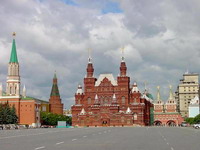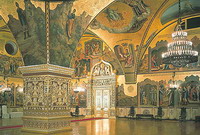Login form
Red Square and Kremlin

Red Square and Kremlin,
The Kremlin, a triangular fortified enclosure in the center of
The Kremlin
The Kremlin (Russian, Kreml') was founded in the 12th century as a fortress within the city.
Today it comprises important government buildings, palaces, and cathedrals within massive fortified walls dating from the 15th century and nearly 2.5 km (1.5 mi) in circumference.
Among the most notable of the secular buildings within the Kremlin are the 19th-century
Dominant among the numerous religious buildings within the Kremlin is the magnificent onion-domed Cathedral of the Assumption, scene of the coronations of tsars (the imperial rulers of

The late-19th-century State Historical Museum.
The embalmed body of former Soviet leader Vladimir Ilich Lenin is displayed for public viewing in a mausoleum on

